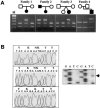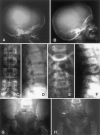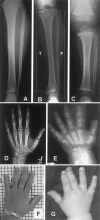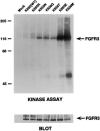Distinct missense mutations of the FGFR3 lys650 codon modulate receptor kinase activation and the severity of the skeletal dysplasia phenotype
- PMID: 11055896
- PMCID: PMC1287918
- DOI: 10.1086/316892
Distinct missense mutations of the FGFR3 lys650 codon modulate receptor kinase activation and the severity of the skeletal dysplasia phenotype
Abstract
The fibroblast growth factor-receptor 3 (FGFR3) Lys650 codon is located within a critical region of the tyrosine kinase-domain activation loop. Two missense mutations in this codon are known to result in strong constitutive activation of the FGFR3 tyrosine kinase and cause three different skeletal dysplasia syndromes-thanatophoric dysplasia type II (TD2) (A1948G [Lys650Glu]) and SADDAN (severe achondroplasia with developmental delay and acanthosis nigricans) syndrome and thanatophoric dysplasia type I (TD1) (both due to A1949T [Lys650Met]). Other mutations within the FGFR3 tyrosine kinase domain (e.g., C1620A or C1620G [both resulting in Asn540Lys]) are known to cause hypochondroplasia, a relatively common but milder skeletal dysplasia. In 90 individuals with suspected clinical diagnoses of hypochondroplasia who do not have Asn540Lys mutations, we screened for mutations, in FGFR3 exon 15, that would disrupt a unique BbsI restriction site that includes the Lys650 codon. We report here the discovery of three novel mutations (G1950T and G1950C [both resulting in Lys650Asn] and A1948C [Lys650Gln]) occurring in six individuals from five families. Several physical and radiological features of these individuals were significantly milder than those in individuals with the Asn540Lys mutations. The Lys650Asn/Gln mutations result in constitutive activation of the FGFR3 tyrosine kinase but to a lesser degree than that observed with the Lys540Glu and Lys650Met mutations. These results demonstrate that different amino acid substitutions at the FGFR3 Lys650 codon can result in several different skeletal dysplasia phenotypes.
Figures







Similar articles
-
A novel skeletal dysplasia with developmental delay and acanthosis nigricans is caused by a Lys650Met mutation in the fibroblast growth factor receptor 3 gene.Am J Hum Genet. 1999 Mar;64(3):722-31. doi: 10.1086/302275. Am J Hum Genet. 1999. PMID: 10053006 Free PMC article.
-
Severe achondroplasia with developmental delay and acanthosis nigricans (SADDAN): phenotypic analysis of a new skeletal dysplasia caused by a Lys650Met mutation in fibroblast growth factor receptor 3.Am J Med Genet. 1999 Jul 2;85(1):53-65. Am J Med Genet. 1999. PMID: 10377013
-
Suppression of severe achondroplasia with developmental delay and acanthosis nigricans by the p.Thr651Pro mutation.Am J Med Genet A. 2014 Jan;164A(1):243-50. doi: 10.1002/ajmg.a.36236. Epub 2013 Oct 29. Am J Med Genet A. 2014. PMID: 24352917
-
The molecular and genetic basis of fibroblast growth factor receptor 3 disorders: the achondroplasia family of skeletal dysplasias, Muenke craniosynostosis, and Crouzon syndrome with acanthosis nigricans.Endocr Rev. 2000 Feb;21(1):23-39. doi: 10.1210/edrv.21.1.0387. Endocr Rev. 2000. PMID: 10696568 Review.
-
Mouse models orthologous to FGFR3-related skeletal dysplasias.Pediatr Pathol Mol Med. 2003 Jan-Feb;22(1):87-103. doi: 10.1080/pdp.22.1.87.103. Pediatr Pathol Mol Med. 2003. PMID: 12687892 Review.
Cited by
-
Molecular Analysis of a Case of Thanatophoric Dysplasia Reveals Two de novo FGFR3 Missense Mutations located in cis.Sultan Qaboos Univ Med J. 2013 Feb;13(1):80-7. doi: 10.12816/0003199. Epub 2013 Feb 27. Sultan Qaboos Univ Med J. 2013. PMID: 23573386 Free PMC article.
-
FGFR3 mutation frequency in 324 cases from the International Skeletal Dysplasia Registry.Mol Genet Genomic Med. 2014 Nov;2(6):497-503. doi: 10.1002/mgg3.96. Epub 2014 Aug 5. Mol Genet Genomic Med. 2014. PMID: 25614871 Free PMC article.
-
Fibroblast growth factor receptor 3-IIIc mediates colorectal cancer growth and migration.Br J Cancer. 2010 Mar 30;102(7):1145-56. doi: 10.1038/sj.bjc.6605596. Epub 2010 Mar 16. Br J Cancer. 2010. PMID: 20234367 Free PMC article.
-
Is fibroblast growth factor receptor 4 a suitable target of cancer therapy?Curr Pharm Des. 2014;20(17):2881-98. doi: 10.2174/13816128113199990594. Curr Pharm Des. 2014. PMID: 23944363 Free PMC article. Review.
-
FGFR3-related condition: a skeletal dysplasia with similarities to thanatophoric dysplasia and SADDAN due to Lys650Met.Skeletal Radiol. 2015 Mar;44(3):441-5. doi: 10.1007/s00256-014-1983-6. Epub 2014 Aug 15. Skeletal Radiol. 2015. PMID: 25119967
References
Electronic-Database Information
-
- Online Mendelian Inheritance in Man (OMIM), http://www.ncbi.nlm.nih.gov/Omim (for hypochondroplasia [MIM 146000])
References
-
- Baker KM, Olson DS, Harding CO, Pauli RM (1997) Long-term survival in typical type 1 thanatophoric dysplasia. Am J Med Genet 70:427–436 - PubMed
-
- Beals RK (1969) Hypochondroplasia: a report of five kindreds. J Bone Joint Surg Am 51-A:728–736 - PubMed
-
- Bellus GA, Bamshad MJ, Przylepa K, Dorst J, Lee RR, Hurko O, Jabs EW, Curry CJ, Wilcox WR, Lachman RS, Rimoin DL, Francomano CA (1999) Severe achondroplasia with developmental delay and acanthosis nigricans (SADDAN): phenotypic analysis of a new skeletal dysplasia caused by the fibroblast growth factor receptor 3 Lys650Met mutation. Am J Med Genet 85:53–65 - PubMed
-
- Bellus GA, McIntosh I, Smith EA, Ayslworth AS, Kaitila I, Horton WA, Greenhaw, FA, Hecht JT, Francomano CA (1995b) A recurrent mutation in the tyrosine kinase domain of fibroblast growth factor receptor 3 causes hypochondroplasia. Nat Genet 10:357–359 - PubMed
Publication types
MeSH terms
Substances
Grants and funding
LinkOut - more resources
Full Text Sources
Other Literature Sources
Molecular Biology Databases

